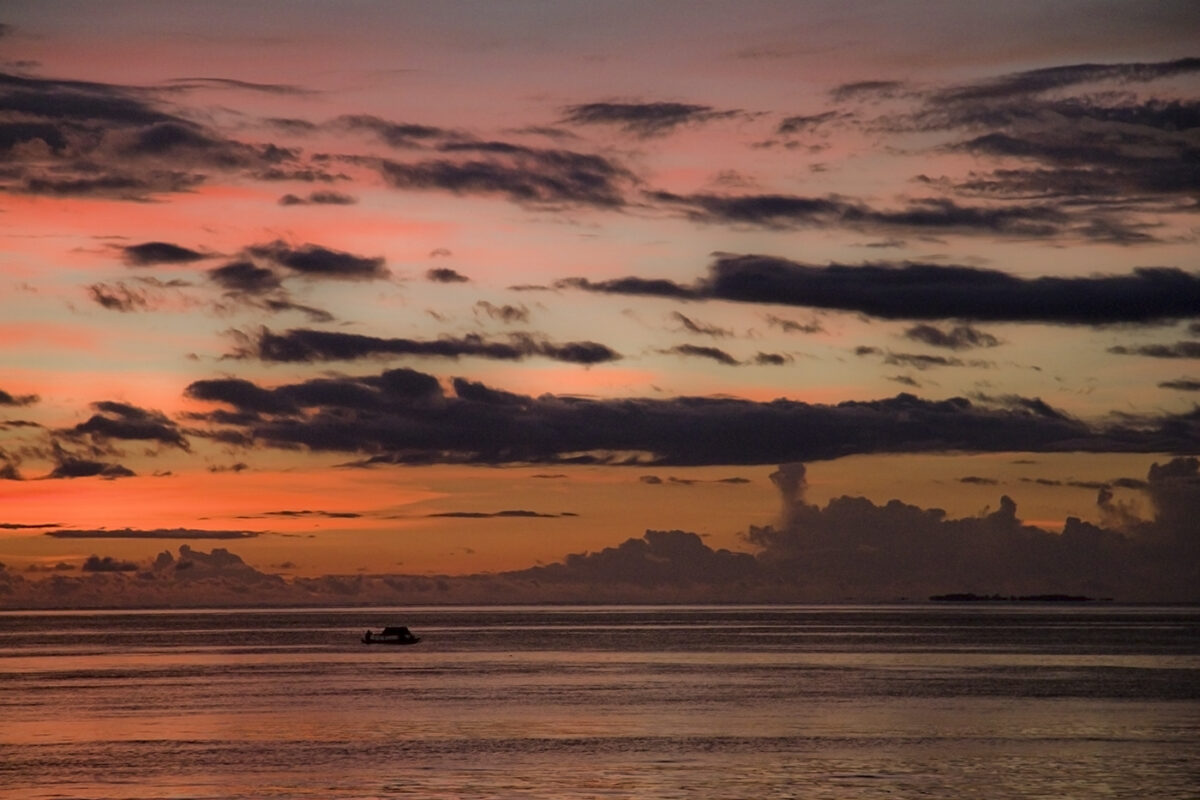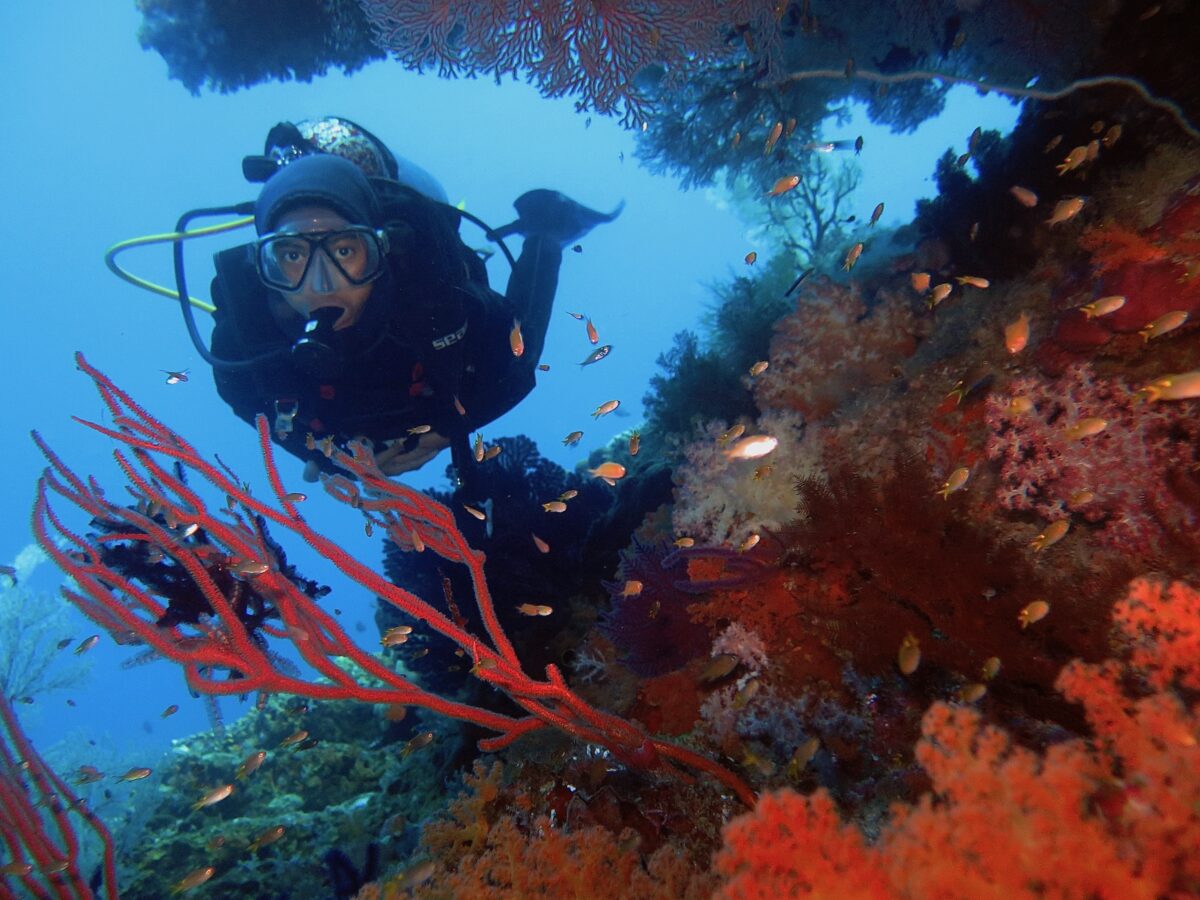Welcome to Raja Ampat, Indonesia: an archipelago home to seascapes beyond description.
For those who daydream of space travel, I suggest Raja Ampat. This far-flung archipelago of 612 islands in the West Papua region of Indonesia is a matrix of worlds beyond the imagination. You will bathe under luminescent stars, meet otherworldly forms of life, and experience that simultaneous sensation of smallness and vastness that I imagine astronauts feel as they float through the cosmic soup.
But first, you have to really want to get there.
There’s a reason the word “paradise” evokes spiritual notions of heaven and the afterlife. Paradise is rare, coveted, elite, and, most of all, mysterious. Divers and environmentalists call Raja Ampat “The Last Paradise,” and rightly so. For starters, it’s a carefully protected marine national park. It’s also geographically distant. Once you make it to Bali or Jakarta, you still have two or three local flights to go. And none shall pass before spending one night prone on the floorboards of a deserted Sulawesi airport. That was me, counting the hours until my bumpy 3 a.m. transfer to Sorong—the first port of arrival to this magical place.
From there, it’s a four-hour ferry ride—vendors with betel nut grins sell dried mango and noodle cups, and they play Rambo on a big screen. Finally, you’ll spend at least two hours in a motorboat to reach your destination. Keep your eyes wide open for lumba-lumba on the way (that’s Bahasa Indonesia for “dolphins”). The journey is its own reward. With each step, you breathe deeper as the rush of civilization recedes, and nature’s elements fill in around you.
The only guide to Bali you’ll ever need →
As in myth, paradise is reserved for those who are willing to go through elaborate trials. That’s how Raja Ampat remains home to the most intact and healthy coral reefs in the world—the bona fide reason for its idyllic nickname. Because it’s difficult and often expensive to visit, it thrives. Its remoteness protects it from the environmental imbalances that tourism brings to the more accessible destinations in Indonesia.
Planning a trip to Raja Ampat on a smaller budget is an even more esoteric experience. The luxury eco-resorts and liveaboards, such as Misool and Silolona, take care of all the details if you go that route—it’ll cost between $500 and $1,000+ per day, depending on the length of your stay and your activities. If you are seeking the authentic and more affordable experience of homestay-hopping, you will spend $20 to $50 per day, plus the cost of your dives. Just be ready to do some digging online. Most travelers use blogs and booking websites to find a well-reviewed first stop based on the diving sites nearby. A good indicator of where to stay are PADI (Professional Association of Diving Instructors) certifications and feedback from previous guests on the quality of the equipment. Once in Raja Ampat, it becomes easier to make connections with other travelers to get recommendations, start island-hopping, and discover the best underwater gems. Scuba diving is the main event here, after all.
I chose the tiny oval-shaped island of Arborek in the north to be my home base. Population: 200. From afar, it looks like a mirage of trees. The palms and mangroves neatly sprout from the still, crystalline waters that hold the island’s true riches—the reefs. Arborek is a simple island with few frills, but its natural abundance is pure luxury. It’s known for its proximity to the world’s most marvelous dive sites, like Melissa’s Garden, Citrus Ridge, and Manta Ridge—and for its dashing good looks. It even won a government-funded award for “most beautiful island” in the region in 2018. Islanders used the prize money to build a cell phone tower, so the WiFi is excellent. You can always find your bearings here if you get lost in paradise. There is even a mini expat community, thanks to Barefoot Conservation—a marine conservation group of scientists and divers that offers visitors the chance to volunteer and receive local accommodation. (Which is how I got here.)
Harrowed by 40+ hours of travel and high on the fact that it would be difficult for anyone I knew to find me here, I arrived on Arborek in a bit of a trance. As I stepped off the boat, a Barefoot Conservation divemaster shouted from the jetty that mantas were paying us a visit. I threw on my snorkeling mask and jumped into the briny, transparent water. Like a vision, a giant pregnant manta floated past me. Hypnotized, I saw her as if in slow motion. A queen of the ocean within arm’s reach, flanked by two male mantas. Her escorts, perhaps—or maybe her lovers.
The day trip: From Ubud, Bali to the Jatiluwih Rice Terrace →
Four months, two PADI certifications, and a hundred or so dives and reef checks later, that hallucinatory, intimate moment with the manta goddess stayed with me. Close encounters with pure life are what inspire people to go through the trouble to travel all this way. Especially during manta season (September through April), when you might find yourself in the unique silence that surrounds divers 15 meters below the surface, surrounded by 50 of them. For me, and for many others, a trip to Raja Ampat is both a pilgrimage and an immersion. It’s a deep education in our simultaneous smallness and vastness. As humans, we are the distinct minority here. And yet, we have so much power. One stick of dynamite can decimate an entire stretch of reef in moments. You see that when you sail to places like Wayag—a wild and breathtaking lagoon above sea level, very much worth the visit. And a mess of dead coral shrapnel beneath, very much worth the reality check.
If you come to Raja Ampat, do so consciously. Stay at a homestay, so that the family can make a living from hospitality rather than from mass fishing. Notice the places where the coral is fading to an eerie white, and remember that when you make choices about your footprint back at home. Absorb the knowledge that we are a part of nature, and we need not only to protect, but also to stand aside. Let the manta and her lovers pass. Be still, watch in awe. Allow that consciousness and humility to influence the way you move through your life, long after she has glided from your view and into the depths of the universe.





